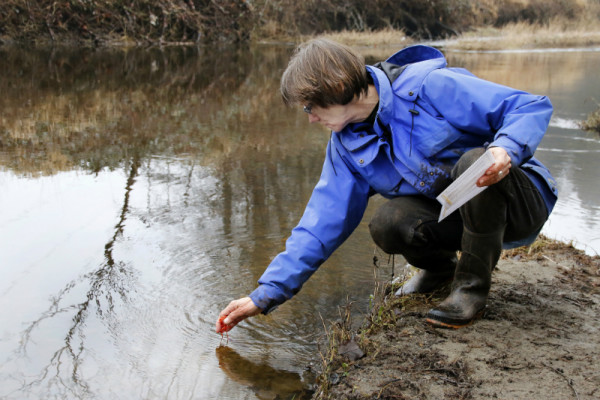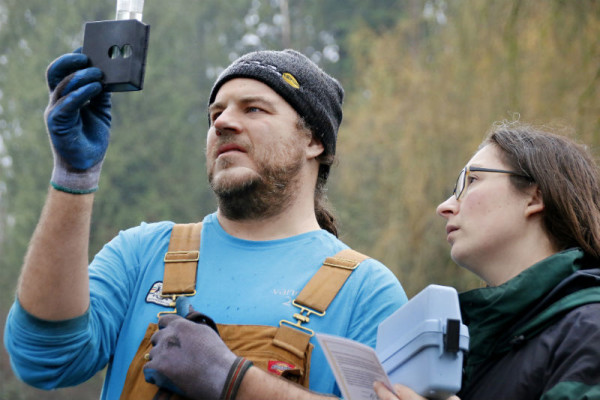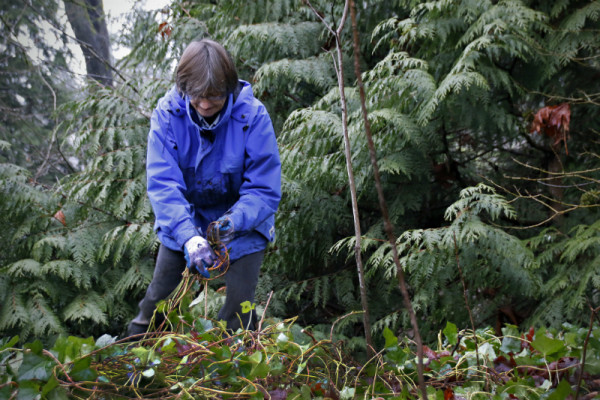I’m an urban watershed steward! What on Earth is that?
Written by Dana McDonald, Manager, Greenspace Programs, Evergreen
The word stewardship is one we at Evergreen use on a daily basis. Usually, we use it to describe the work that volunteers do to restore public green spaces at our regular events. But it’s more than that – to be a steward is to handle something with care and intention, and to work towards improving its condition.
Anyone can be a steward. CEOs steward their organizations to meet the goals of their board members and their missions. Neighbours steward their backyard gardens to make a home for the bees and a feast for the eyes and fundraisers steward their donors to make sure the funder understands the impact their donation is having on a project. Urban watershed stewards contribute to local stream and riparian (stream banks) restoration efforts, make decisions that minimize impacts on downstream waterbodies, and encourage members of their wider community to do the same.
Now, you might ask: What’s a watershed? A watershed is an area of land – its boundary higher in elevation than its centre – within which any drop of water that falls or flows will travel a path toward a common downstream creek, lake, river or ocean. No matter where your footsteps land or lead, you are in a watershed. We can all imagine towering mountain peaks with streams flowing down their slopes toward a common point, but what about watersheds in the city?
Herein, I will describe for you the elusive and omnipresent urban watershed. Have you ever been walking by a storm drain on a sunny day and heard the gushing sound of flowing water under your feet? What you’re hearing is a stream – the very same kind of stream you’d find in the forest, but this one is in a pipe under the street. During early phases of urban development, city builders found streams to be a convenient means of conveying sewage and storm runoff to lakes, rivers and oceans. They encapsulated the streams within a system of underground pipes, connected them with stormwater systems, and lay streets over top.
As populations grew and new cities were constructed, we began to better understand the value of streams for wildlife, recreation, aesthetics, and resilience to extreme weather. And so, cities began to build around, rather than over streams, providing an environment to which us urban stewards can contribute a great deal.
How can you co-exist with urban watersheds?
- Become a steward! It’s as simple as striking up a conversation with your neighbour about how to tackle the blocked storm drain at the end of your street.
- Slow down stormwater: build a rain garden, replace pavement with a permeable surface, or install a rain barrel to retain runoff on your property and minimize the likelihood of extreme conditions in streams (and a flood in your basement).
- Have fun! Get out and about in your watershed to learn more about how it works – where does the water you see come from? Where does it go? What happens to it along the way?
- Join Evergreen’s Uncover Your Creeks volunteers in Vancouver or Toronto or another local initiative in your watershed.
Evergreen’s Uncover Your Creeks program brings volunteers to urban green spaces across Metro Vancouver and the GTA. At each event, volunteers identify native and invasive plants, observe local wildlife, restore biodiversity to stream banks and sample water quality. The restoration activities are guided by local management plans, and water quality data is uploaded to CURA H20, a nationwide data-sharing initiative hosted at St. Mary’s University in Nova Scotia.
Find out more by visiting Evergreen’s website.
Evergreen is a national not-for-profit dedicated to inspiring action to green cities. The Uncover Your Creeks program is generously supported by WWF’s Loblaw Water Fund, HSBC, the Real Estate Foundation of British Columbia, Fortis BC, Environment Canada EcoAction, the Public Conservation Assistance Fund and the TD Friends of the Environment Foundation.
If you’re a registered charity or not-for-profit, you can find this year’s Applications and Guidelines for the Loblaw Water Fund at wwf.ca/waterfund until December 14, 2015.




